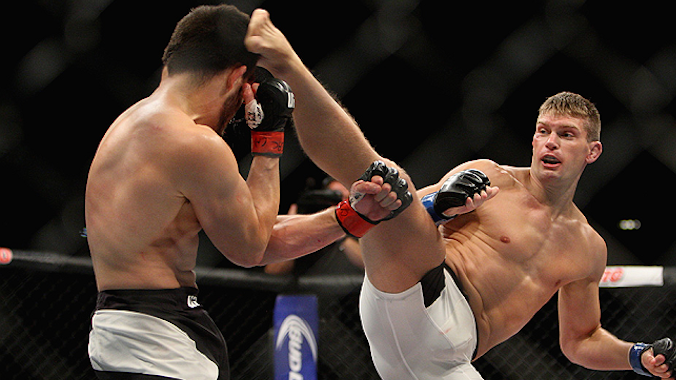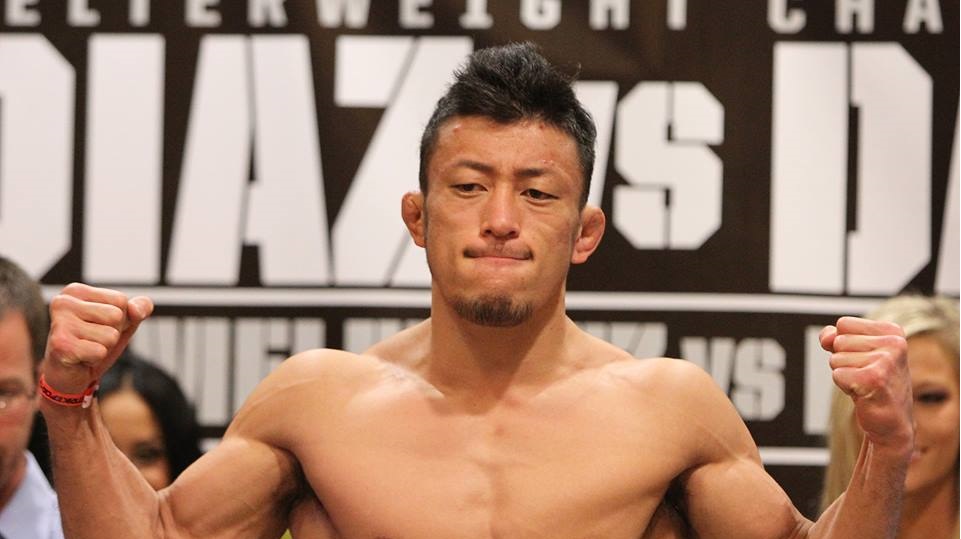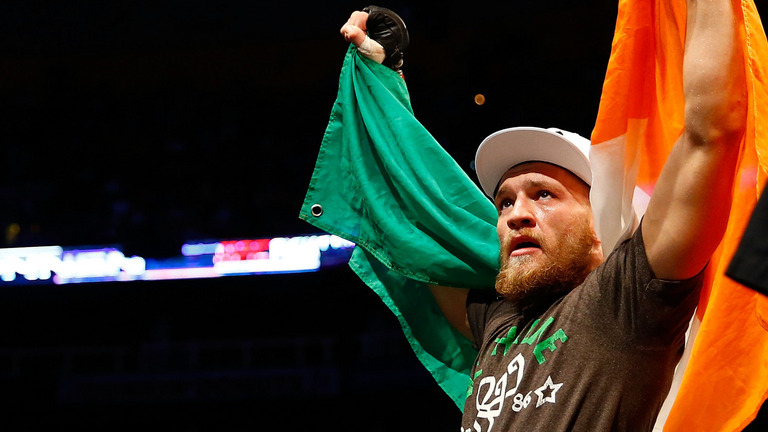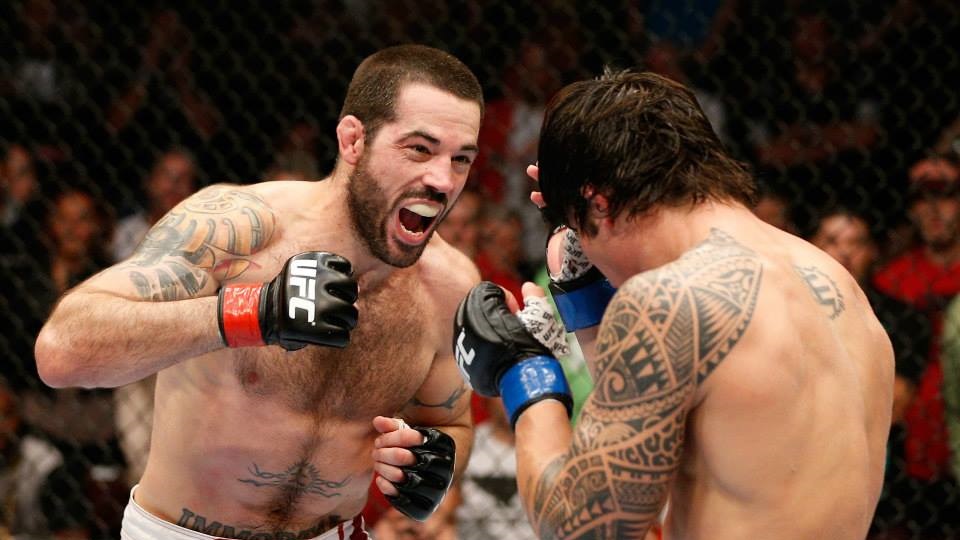
Whether they admit it or not, every fight fan loves to watch two knockout artists go to war. It’s the layman’s physics conundrum: what happens when an unstoppable force meets another unstoppable force?
At Bellator 140, the question will be answered as welterweight challenger Andrey Koreshkov attempts to dethrone champion Douglas Lima.
“The Phenom”
Douglas Lima is “the leg kick guy”. Not that the moniker is wholly undeserved.
From a technical standpoint Lima is certainly one of the better kickers. Watch the gif again as Lima turns his hip over beautifully so that the kick connects at a perfect 90 degree angle to Tsarev’s knee. But Lima’s strengths aren’t in his leg kicks.
Douglas Lima, believe it or not, is a counter fighter through and through. Because of his height, hulking physique (cutting from 190+ usually) and long legs it’s very easy to forget that Lima has a relatively small reach of 71”. Barring Rick Hawn, Lima has given up reach in every single one of his Bellator wins.
Despite or, rather, because Lima gives up reach he is a very good judge of distance. Similar to Tatsuya Kawajiri in his prime (whom I analyzed a while ago) Lima is very good at maintaining proper; he constantly shuffles to keep opponents on the end of their range.
At 6’ 1” the reach on his legs is still very good, and Lima uses kicks on every level to punish opponents at maximum range. With four knockouts via kicks (two head, two legs) opponents can rarely afford sit back and allow Lima to punt them silly. So nearly every fighter tries to walk forward and exchange with Lima. This forces his opponents to try and close with strikes and when they open up, Lima often steps in and counters at a range where his shorter arms have the advantage.
Watch as Chris Lozano (already having taken serious shots) throws a long jab only to have Lima roll with it, close distance and land a beautiful straight right in one fluid sequence.
Both of Lima’s highlight reel knockouts over Ben Saunders were a result of Saunders eating leg kicks at maximum range and trying to close distance with long punches. When he did Lima’s shorter reach and greater power caught him and set up the end of the fight.
So what are Lima’s shortcomings? Well, despite his excellent technique when throwing leg kicks his set ups are borderline nonexistent.
Even against his most recent opponent Hawn, Lima didn’t set up his kicks; he simply walked the smaller man down and threw single leg kicks until the fight ended. If the fighters don’t check leg kicks (at least, until they do real damage) then perfect. But as Anderson Silva showed in his rematch with Chris Weidman, throwing a no set up hard leg kick against a good checker is asking for trouble.
Compare Lima to the two most prolific leg kickers in the UFC: Jose Aldo and Edson Barboza.
Whether it’s a cracking 1-2 to the head, a level change for a body shot, or even stepping forward with the mere threat of a punch most of their opponents are too preoccupied to focus on stopping the leg kick. Watch Barboza repeatedly chain punches before punting Etim’s unprotected leg.
Another far more serious flaw is that Lima is rather easy to walk down. Because of the lower average talent in Bellator than the UFC (not trying to be rude, just speaking the truth) only Ben Saunders was able to consistently exploit this flaw. Due to his two knockout losses fans often forget that until the fight changing punches Saunders was able to hold his own against Lima simply by using his long kicks to force Lima back before pressing him against the cage for the clinch.
The fence, unfortunately, is a bad place to be against his challenger.
“The Spartan”
Andrey Koreshkov is Russian but, without meaning to engage in stereotypes, looks nothing like the stereotypical Soviet bloc mixed martial artist. Rather than being compact and barrel chested, he is long and lean. But Koreshkov immediately dispels any questions about his origins when he begins fighting; he hits like a T-34 tank and stalks his enemies with the indifference of a high school student analyzing A Catcher in the Rye.
Koreshkov’s lanky build which I poked fun at is a big reason he is such a nightmare; he’s very long. Standing at 6’ 1” with a 74” inch reach Koreshkov is the perfect length, reaping all the benefits of range without sacrificing athleticism.
While he is a looping puncher (odd for a rangy fighter) Koreshkov makes this work by having great technique, great hand speed and a great understanding of his effective range. He’s not above using spinning kicks at ranges that he can’t be countered and even has good leg kicks. His jab is excellent but primarily used as a range finder, snaking back and forth until the terrifying Russian is confident he has found his range.
What makes Koreshkov so good is that he uses strikes to set up other strikes. If the opponent’s guard is high he will close distance and sink pinpoint body punches until the guard comes back down at which point he’ll continue head hunting. He’ll hit opponents at range until they come in at which point he’ll secure a clinch and begin kneeing them. If an opponent is moving on a straight line to avoid hooks, he’ll step in with a spinning back kick whose range doesn’t allow the opponent to back away in time.
But the absolute bread and butter of Koreshkov’s set ups is the hook into the uppercut. Because mixed martial arts gloves are so small, properly blocking hooks requires the hands and forearms to be wide and high which leaves the middle open. Conor McGregor used the exact opposite set up against Dustin Poirier by hitting him with straight lefts until his guard came in and then hooking around it.
Tiawan Howard may be 11-12 now but it’s worth noting that a disproportionate amount of those losses are via submission; he is more than adequate on the feet yet didn’t stand a chance against Koreshkov. After having his opponent’s thunderous hook glance off his head Howard kept his hands at his forehead, at which point Koreshkov threw a perfect uppercut in between his elbows for a one punch knockout.
While the Howard fight is the most dramatic example, it is remarkable how often Koreshkov’s uppercut connects. The uppercut is a powerful but low percentage punch that has limited range and leaves a fighter horribly open on the unguarded side (see James Te Huna against Shogun Rua) yet Koreshkov manages to stagger fighters with it on a regular basis.
Koreshkov is also talented at herding fighters into his punches, allowing terrified opponents to circle the cage as he hits them with punches from the opposite sides. Unlike say, Matt Brown and Mark Hunt, Koreshkov doesn’t have a knack for connecting cleanly but he still slows opponents down enough that they eat multiple shots.
If you have a minute to kill, I’d urge you to watch Koreshkov chain all these techniques together in his destruction of Justin Baesman.
The Match-Up
Koreshkov likes to go forward and Lima loves fighters that come forward. But the fight is so much more than that.
Lima is limited to kicks at maximum range of which Koreshkov has shown to be adept at sliding out of range. When Koreshkov is close enough he responds to kicks by throwing vicious combinations against his unbalanced opponent. Unlike many of Lima’s opponents who awkwardly try to close distance with reaching punches Koreshkov is polished and accurate enough that he is a very real threat when he closes in on Lima.
Lima is the champion for a reason, but I truly don’t see how this match-up is in his favor. Perhaps he won’t be finished but he will likely go the way of Adam McDonough; reduced to covering up and circling away as the Russian’s haymakers rattle his brain through his guard.
Andrey Koreshkov via unanimous decision



















